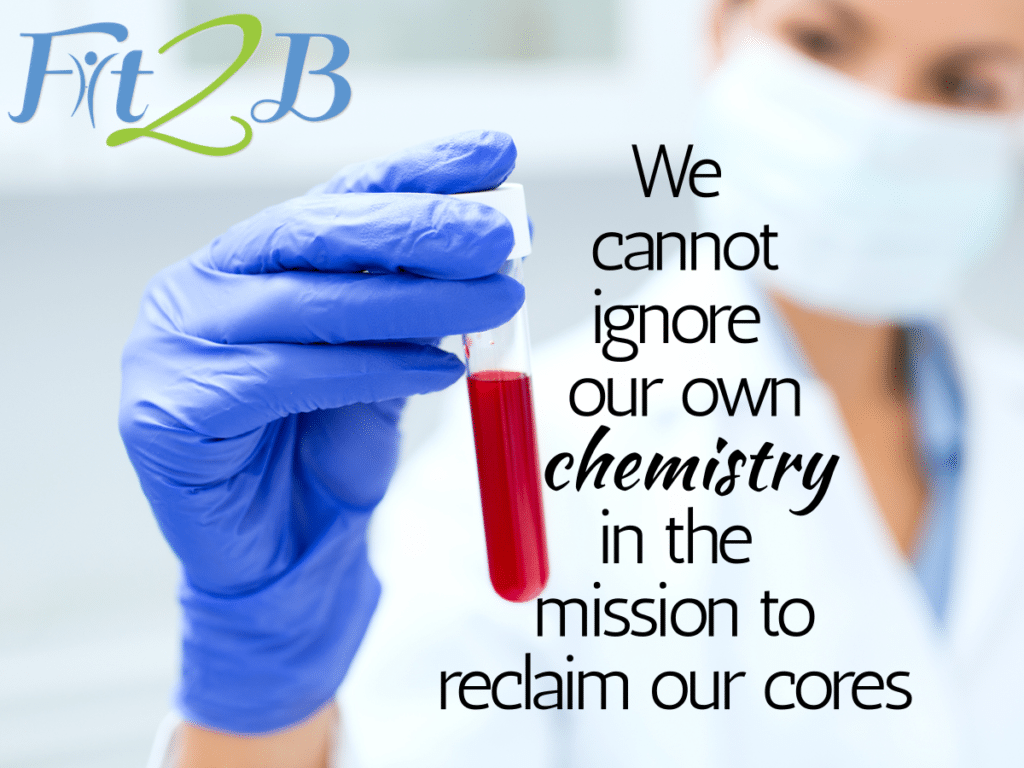Blog
How Your Chemistry Affects Your Diastasis Recti
Continuing our flashback of “The Unclosed Core” series, we thought you would appreciate this updated blog with current information that will encourage you to persevere.
In Part One of this 4-part series, I introduced our general topic of “hope for when that diastasis recti will not close.” In Part Three, I will discuss “How Your Emotions Affect Your Diastasis Recti,” and I’ll talk about biomechanics and some new tools and props in Part Four. Here in Part Two, I want to focus on some factors that figure into your personal chemistry.
Why chemistry?
Normally, I stick to the fitness. I have a degree in it. I’m certified in it. I’ve taught it for over 20 years. I’m really good at it. I’m not a nutritionist. I’m not a chemist. I’m not a biologist or a biomechanist, but experience has taught me a LOT about how bodies respond to various stimuli, and we cannot ignore our own chemistry as a major role player in the mission to reclaim our cores and get our abs back where they belong.
When I was getting my degree in Exercise and Sport Science from Oregon State University, I was required to take a year of biology and a year of chemistry as part of the baccalaureate core. This was in addition to all the anatomy, physiology, kinesiology, nutrition, and other classes such as psychosocial dimensions of sport in physical activity. This article series is based on what I learned in college combined with studying diastasis rectus abdominus (DRA) devotedly since early 2011. It’s also my own theories based on talking with hundreds of clients worldwide, interviews with nutritionists, discussions with colleagues, my continuing education, and many hours staring off into space and letting my mind connect the dots.
This will, by no means, be an extensive research article. It’s a summary of fresh ideas for my average readers who might feel like they’re at a plateau with their pooch. They’ve done all the actions and rehab to narrow their DRA, but the stinkin’ thing is still wider and deeper than optimal for full function. The point I will try to drive home is that we can do all the right things during our rehab sessions and during our specialized workouts such as what Fit2B provides here on this home fitness website, but if what we’re doing on the outside isn’t complemented by what’s happening on the inside, healing will be dramatically slowed.
We can create an environment INSIDE ourselves that nurtures fascial re-creation.
Every thing in your body breaks down into chemical compounds. We are just one huge “Table of the Elements,” and the way one part of your body triggers another part of your body is basically through electro-chemical messaging along conductive pathways along your nerves and through your blood vessels. (Super-simplified: think text messaging, only faster.)
Emotions are essentially chemical messengers, as are hormones. Can any of us deny how being in a bad mood affects our desire to work out? How being sad changes our posture? Or how food can energize us or make us want to take a nap? Your mama wasn’t lying when she told you that “you are what you eat!”
It’s all connected!
Except it’s not just what we eat but also how much rest we’re getting, how much stress we’re experiencing, what our hormones are doing, the manner in which we’re moving — ALL of that affects our internal chemistry which in turn affects how fast we rebuild after something breaks.
To warm you up to where I’m going, here are some familiar examples of chemistry affecting things besides our core:
- Daddies – When new fathers are expecting their first child, their bodies will secrete more cortisol, a protective “fight” hormone that readies us for conflict and battle. Just knowing they’re going to be a daddy stimulates a hormonal change that affects their body’s chemistry, and many men will gain weight while they wait for their baby to come because cortisol increases cravings. It also makes them more protective, so they’re “on guard” more. Meet Papa Bear.
- Mommies – We know that pregnancy stimulates the release of relaxin which targets the connective tissue of our pelvis. In hypermobile people with hypersensitive relaxin receptors, they might find other joints loosening as well. But did you know that breastfeeding keeps those “softening” hormones in a woman’s system until 3-6 months after baby is weaned? Here’s an article from my NZ colleague Loraine Scapens about “Running and Breastfeeding.”
- Turkeys – Thanksgiving day. Everyone is stuffed with mom’s infamous casserole, Aunt Melody’s pie, and Dad’s turkey. Turkey has tryptophan in it which stimulates a release of seratonin, the sleepy hormone. Actually, all poultry has the same amount of tryptophan, so it’s overeating and being exhausted from all the holiday rushing that’s to blame for making us sleepy. Very sleepy. Thus all the post-meal snoring coming from the living room. But you get my point.
So Mom was right: we are what we eat. However, we also are NOT what we are NOT eating.
We require certain elements, nutrients, and compounds for our bodies to maintain bone and tissue strength. If we are deficient in the things that encourage bone remodeling, fascial reconstruction and muscle building, then we can move in all the right ways, but the healing will be slow or nonexistent.
Here are some things already inside us and things we can put inside us that affect our chemistry in ways that also affect our cores…
Womanhood
If you are a woman of childbearing age, you have to take reproductive and menstrual cycles into account when giving your DRA time to close. Our bodies “act pregnant” during the last few days before we get our periods when estrogen and progesterone have both dropped. Most diastasis will be a bit wider around this time of the month, so don’t check it then!
If you’re breastfeeding, your body cranks out more relaxin every time you nurse your baby. Once baby is weaned, as I said above, it takes several months for those tissue-softening hormones to clear out of your system. It’s not like you quit breastfeeding and, BOOM! Healed core! Wouldn’t that be great? However, please do not stop nursing your baby just to narrow your DRA. There are many other things you can do begin narrowing it while you continue to breastfeed, priming it to close completely just a few months after you’re done weaning. Unless your DRA is debilitating you to the point of damaging your marriage and motherhood, the benefits to your baby far outweigh the risks of having a diastasis that sticks around a little longer. Please nurse for at least 6 months to 1 year before considering weaning as an additional help in healing your core. I nursed my two for a total of 60 months, and my DRA healed nicely when I was done.
Menopause also alters the hormone balance of women. Things don’t heal as fast as teenagers, for sure, but they do heal. I’ve witnessed many women in their 60s, 70s, and even 80s fix their tummies after learning about DRA for the first time. Imagine what a different life they would have had if they’d known sooner! Don’t decide that you won’t get any further just because you’re older. A muscle is a muscle, no matter how old, no matter how small, no matter how tall!
Iron
Kelly Dean, LPT at The Tummy Team, says, “Eat more iron! Lack of iron can cause fatigue and poor concentration — the last thing we moms need! Eat foods rich in iron and the bonus is it helps keep you full!” Iron is important to a healing core. If we don’t get enough iron, we will be more tired. If we’re tired, we won’t have energy for alignment, exercising, etc. Notice how most of these are also high in protein which is what your body needs to rebuild structures.

Supplements
We are very deficient in so many things these days. Processed foods, enriched foods, fast foods — all these remove a lot of the “good” in them that our bodies need. We do not eat as close to the earth as our ancestors did, and we sit way more than they did. Many are turning to supplements, and there are several which I believe contribute to rebuilding connective tissue. Please do your own research on what is available in your area. I’m only covering a few here so as not to overwhelm you:
Magnesium – Good ol’ Group 2, Atomic number 12 Mg helps in the relaxation phase of muscle actions, and it helps my moods a lot. Interestingly, worldly uses are quite pyrotechnic, and it’s often used as an incendiary device to start fires. Moods. Fires. No connection there. Nope. (Ha!)
Calcium – Jumping up and down stimulates the osteoblasts in your bones to lay down new bone matrix IF you have enough calcium in your bloodstream. If you aren’t consuming enough, your bones will pull those ions from your muscles. But your muscles need calcium to flex just like they need magnesium to relax. If you’re pregnant and exercising and depleted, that’s another downward chemical spiral that affects your abdominal musculature.
Collagen – A tablespoon of collagen powder (and the 6.5 grams of protein it contains) goes into my coffee each morning. I can’t even taste it, and I wrote a really cool article about it here for Smithspirations. Your bones, nails, hair, fascia, and ligaments are made out of collagen. When you’re not consuming enough of this essential building block via protein-rich foods, your tissues have to “rob Peter to pay Paul” so to speak. Taking a collagen supplement helps to support the rebuilding of the fascial matrix in our abs and elsewhere.
Herbs & plants
I’ve always been fascinated by plants, herbs, and natural healing. Here on our farm, we raise our animals as naturally as we can with plant-based treatments. Just like I mix up elderberry syrup each winter to fight off colds, I believe there are plant-based substances that can facilitate fixing fascia as well.
Herbalists have been treating human tissue damage with herbs since the dawn of time, so I reached out to certified advanced herbalist Kristie Miller of Land of Havilah Herbals, and asked her what she’d recommend for people dealing with diastasis recti…
“I always prefer to use Complete Tissue & Bone Formula with the Vitalerbs Formula, which supplies the body with extra nutrition and when we use it together with the Complete Tissue & Bone Formula, we route extra nutrients to the area that the body needs it the most.
“Herbal Calcium Formula is definitely something that I would consider in this situation. It provides the body with plant-based silica which helps in the assimilation of calcium, allowing the body to heal faster.
“The above formulas are for oral use (taken by mouth). It is very beneficial to also use herbs externally, directly on the area. Complete Tissue & Bone Ointment is nice for this situation.”
-Kristie Miller, Certified Herbalist, Advanced Herbalist, Landofhavilahfarm.com
Just two more things …
First: water
Those two molecules of hydrogen combined with one molecule of oxygen are vitally important! If your tissues aren’t lubricated, things don’t slide right. And if a high blood alcohol content can affect you, just imagine how basic hydration changes your blood! What you circulate to your healing tissues matters!

Last but NOT least: emotions
Emotions read like chemical washes in the body. This is why we cry over sappy commercials, get goose bumps when we witness something astounding, shudder or feel like gagging when something is gross to us. Feelings are very much physical, and those responses often happen without us “making” them happen. They just happen.
Seriously, I have so much to say on how stress and emotions change our chemistry thus affecting our ability to get better — even at the core level — that I’m saving it for the next blog in Part Three: How Do Your Emotions Affect Your Diastasis Recti?
Meanwhile, please go back and read Part One if you didn’t already, and also this one about giving your diastasis time to heal.




Is relaxin still there if the pregnancy is 24 month away?
I always thought it is an pregnancy hormon!?
(I’m still breastfeeding i forgot to say?)
As long as you’re breastfeeding, relaxin will be in your system because it assists in the lactation process. It’s why you feel “relaxed” after a let-down and long nursing session In face, the hormone is found in the system up to 6 months after the last nursing session.
Hello, I have been spending some time in your blog tonight. Great articles! I am 13 months pp after my 3rd baby and an still nursing. I just started physical therapy to close my DR which is over 4 fingers below my belly button. Is it possible to effect any change while nursing or am I wasting my time?
While the hormones released during BFing won’t fully leave your system for 6-12 months after you finish feeding, and while they do affect how quickly the fascia in your pelvis (which includes your abdominal fascia below your navel) heals, there is much you can do to strengthen and stabilize your core so that your DR narrows that much quicker once those hormones are gone. Feeding your baby is so important. A diastasis can be healed – literally – anytime! We know how to help that happen. But this season of life with your babe… so precious and only for right now. I BF’d my two for a total of 60 months. I miss it deeply.
Pingback: Giving diastasis recti time to heal
Pingback: How Emotions Affect Your Diastasis Recti | Fit2B Studio
Pingback: Dr. Demetro’s 6-Week Anti-Inflammatory Diet | Fit2B Studio
Pingback: A Naturopathic Doctor's Anti-Inflammatory Diet Guide | Fit2B Studio
Pingback: So You Have Diastasis Recti... Now What? | Fit2B Studio